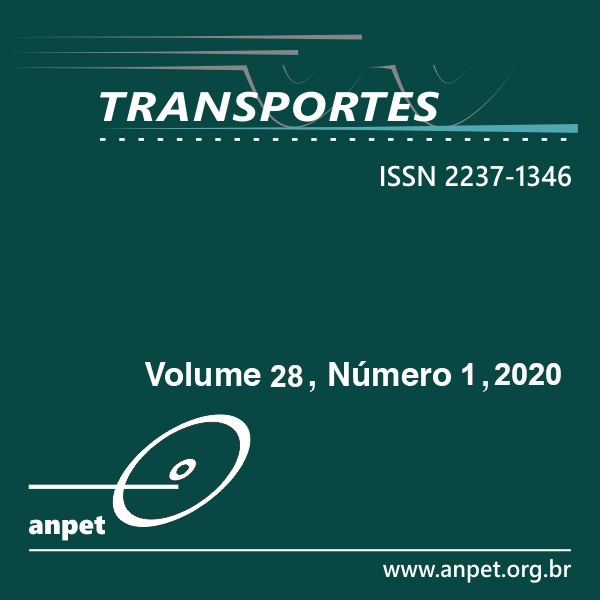Estudo da separação entre pistas de pouso e decolagem e de taxiamento em aeródromos brasileiros – aplicação ao Aeroporto Internacional de Fortaleza
DOI:
https://doi.org/10.14295/transportes.v28i1.1934Keywords:
Safety, Risk analysis, Parallel taxiways, Collision.Abstract
Deviations from geometric design standards are common in airports around the world. In several Brazilian Airports, there are non-conformities in distances between parallel runways and taxiways, which are lower than the requirements set by the National Civil Aviation Agency. This paper aims to assess the impact of such deviations on the risk of collisions associated with simultaneous operations on the airport site, especially in the case of instruments’ operation. To do so, a risk analysis method proposed by the Airport Cooperative Research Program of the Transportation Research Board was applied with three different aircraft types that operate at Fortaleza International Airport. It was found that there is a low probability of accidents and that the method used is an effective way to quantify the operational risk of lower-than-standard separations between parallels runway and taxiways, being this approach useful for similar situations.Downloads
References
ANAC (2012). Regulamento Brasileiro da Aviação Civil – RBAC nº154, Emenda nº 01: Projeto de Aeródromos. Secretaria da Avia-ção Civil, Brasília, DF.
ANAC (2015). Regulamento Brasileiro da Aviação Civil – RBAC nº139, Emenda nº 05: Certificação Operacional de Aeroportos. Secretaria da Aviação Civil, Brasília, DF.
ANAC (2018). Regulamento Brasileiro da Aviação Civil – RBAC nº154, Emenda nº 03: Projeto de Aeródromos. Secretaria da Aviação Civil, Brasília, DF.
Ayres Jr., M.; Shirazi, H.; Carvalho, R.; Hall Jr., J. W.; Speir, R.; Arambula, E. David, R.; Gadzinski, J.; Caves, R.; Wong, D.; Pitfield, D. (2013) Modelling the location and consequences of aircraft accidents. Safety Science, V. 51, 178-186. DOI: https://doi.org/10.1016/j.ssci.2012.05.012.
Ayres Jr, M.; Carvalho, R.; Shirazi, H.; David, R. E. (2014) ACRP Report 107 - Development of a runway veer-off location distribution risk assessment model and reporting template. Transportation Research Board (TRB), Washington-DC, EUA.
FAA (2012). Advisory Circular AC nº 150/5300-13A: Airport Design. Federal Aviation Administration, U.S. Department of Transportation, EUA.
Fernandes, H. F.; Müller, C.; Alves, C. J. P. (2018) Avaliação dos requisitos da faixa de pista em aeroportos regionais: uma análi-se de risco. Revista Transportes, v. 26, p 76-91. DOI: 10.14295/transportes.v26i4.1478
Hall Jr., J.; Ayres Jr., M.; Wong, D.; Appleyard, A.; Eddowes, M.; Speir, R.; Pitfield, D.; Caves, R.; Selezneva, O.; Puzin, T. (2008) ACRP Report 3 - Analysis of aircraft overruns and undershoots for runway safety areas. Transportation Research Board (TRB), Washington, D.C., EUA.
Hall Jr., J.; Ayres Jr., M.; Shirazi, H.; Speir, R.; Carvalho, R.; David, R.; Huang, Y. (2011) ACRP Report 51 - Risk assessment method to support modification of airfield separation standards. Transportation Research Board (TRB), Washington-DC, EUA.
Huang Z. (2018) Sensitivity Analysis of Runway Veer-off Risk Assessment. Master of Science in Civil Engineering for Risk Miti-gation, School of Civil, Environmental and Land Management Engineering, Politecnico di Milano, Milão, Itália.
ICAO (2018) Annex 14 to the Convention on International Civil Aviation - Aerodrome Design and Operations. 8th Edition. International Civil Aviation Organization. Montreal, Canadá.
Ketabdari, M.; Giustozzi, F.; Crispino, M. (2017) Sensitivity analysis of influencing factors in probabilistic risk assessment for airports. Safety Science. DOI: http://dx.doi.org/10.1016/j.ssci.2017.07.005
REDEMET (2018) Meteorological Aerodrome Report – Aeroporto Internacional de Fortaleza – 2018. Rede Meteorologia do Co-mando da Aeronáutica. https://www.redemet.aer.mil.br/?i=produtos&p=consulta-de-mensagens-opmet (dezembro, 2018).
Travers, P. C. (1995) New large aircraft. Institution of Mechanical Engineers Journal, V. 209. Birmingham, Reino Unido.
Downloads
Published
How to Cite
Issue
Section
License
Authors who submit papers for publication by TRANSPORTES agree to the following terms:
- The authors retain the copyright and grant Transportes the right of first publication of the manuscript, without any financial charge, and waive any other remuneration for its publication by ANPET.
- Upon publication by Transportes, the manuscript is automatically licensed under the Creative Commons License CC BY 4.0 license. This license permits the work to be shared with proper attribution to the authors and its original publication in this journal, and to be adapted for non-commercial purposes, provided appropriate credit is given and any derivative works are distributed under the same terms.
- Authors are authorized to enter into additional separate contracts for the non-exclusive distribution of the version of the manuscript published in this journal (e.g., publishing in an institutional repository or as a book chapter), with recognition of the initial publication in this journal, provided that such a contract does not imply an endorsement of the content of the manuscript or the new medium by ANPET.
- Authors are permitted and encouraged to publish and distribute their work online (e.g., in institutional repositories or on their personal websites) after the editorial process is complete. As Transportes provides open access to all published issues, authors are encouraged to use links to the DOI of their article in these cases.
- Authors guarantee that they have obtained the necessary authorization from their employers for the transfer of rights under this agreement, if these employers hold any copyright over the manuscript. Additionally, authors assume all responsibility for any copyright infringements by these employers, releasing ANPET and Transportes from any responsibility in this regard.
- Authors assume full responsibility for the content of the manuscript, including the necessary and appropriate authorizations for the disclosure of collected data and obtained results, releasing ANPET and Transportes from any responsibility in this regard.









